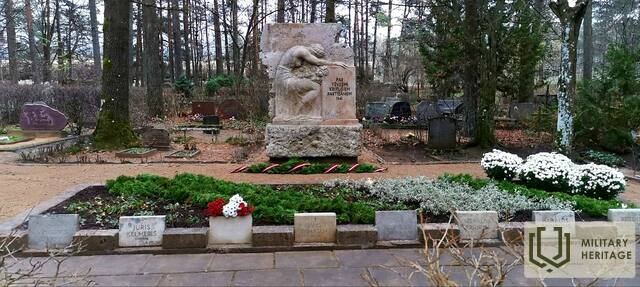Paminklas „Sėdinčiai motinai“ Inčukalno garbės kapinėse
Memorialinė vieta

 50
50



Yra: Inčukalno savivaldybė, Inčukalns, Miera gatvė, Inčukalno kapinės.
Paminklas atidengtas: 1944 m. liepos 16 d. Paminklas atidengtas po K. Zālės mirties. Užrašas: Žuvusiems Tėvynės partizanams 1941 m. (atkurtas). Paminklas restauruotas 2020 m. lapkričio 5 d. Paminklas restauruotas remiant Inčukalno regioninei tarybai. Restauratorius menininkas Igoris Dobičinas.
Įvykiai: „1940 m. birželio 17 d. Latviją okupavo SSRS. 1941 m. birželio 14 d. buvo vykdomos trėmimai. 1941 m. birželio 22 d. Vokietija užpuolė SSRS, ir Vermachto daliniai įžengė į Latviją. Raudonoji armija ir jos rėmėjai atsitraukė. Daugelyje Latvijos vietų – įskaitant Raganą, Sėją ir Inčukalną – buvę sargybiniai ir patriotiškai nusiteikęs jaunimas organizavosi ginti savo namų ir skubėti išvyti sovietų okupantus. Kai 1941 m. liepos 1 d. Sėjos valsčiaus „Ziediņi“ (Gėlės) rajone vėl buvo iškelta Latvijos Laisvosios Valstybės vėliava, specialieji Raudonosios armijos daliniai Šiaurinėse kapinėse sušaudė šio namo savininkę – 39 metų Elzą Višą, o Sėjos ir Krimuldos valsčių pasienyje – jos motiną – 64 metų Elzą Martinovą. Tai sukėlė dar daugiau neapykantos ir pasipiktinimo tarp vietovės gyventojų, ir jie pradėjo...“ susiburti į liaudies pasipriešinimo judėjimą ir kurti savigynos būrius, kurie dar buvo vadinami pirmaisiais partizanais (Inčukalno grupės vadas buvo Maksis Cālītis). Prie regiono kovotojų prisijungė ir iš Litenės karinės stovyklos pabėgę arba paleisti vadinamojo Latvijos teritorinio korpuso kareiviai bei karininkai. Po kelių dienų, liepos 4 d., įvyko ginkluotas susidūrimas su raudonaisiais, mūšyje žuvo septyni kareiviai ir Raganos vaistininko sūnus Pēteris Prašķēvičs. Be to, Raganos mūšyje buvo sužeistas ir paimtas į nelaisvę 17 metų Rėzeknės mokytojų instituto studentas Jānis Porietis, kuris buvo kankinamas, sušaudytas ir palaidotas netoli Straupės.
Čia, Inčukalnyje, buvo iškastas bendras brolių kapas, į kurį aštuoniais arklių traukiamais vežimais po vieną buvo vežami iš baltų neobliuotų lentų pagaminti karstai, kad žuvę didvyriai galėtų ilsėtis gimtojoje žemėje. Po kelių mėnesių, jau vokiečių okupacijos metu, kapinėse buvo įrengtas Kārlio Zāleso (nuo 1939 m. iki gyvenimo pabaigos 1942 m. vasario 19 d., dėl sunkios ligos genialusis latvių skulptorius pasirinko Inčukalną savo gyvenamąja vieta) suprojektuotas paminklas – sielvartaujančios motinos ant rožių kelių atvaizdas. 1950-aisiais vietos komunistų aktyvistai paminklą susprogdino. Paminklas apgadintas ir nejudantis gulėjo iki pat Atgimimo, kai 1980-ųjų pabaigoje vis daugiau žmonių susidomėjo ir kalbėjo apie 1941 m. liepos 4 d. įvykius bei ragino restauruoti Kārlio Zāleso paminklą. Šis reikalavimas buvo išsakytas 1988 m. rugsėjo 8 d. Inčukalno pradinėje mokykloje sušauktame žmonių ir valdžios susirinkime, kuriame dalyvavo ne tik Inčukalno gyventojai, bet ir netoliese esančių parapijų gyventojai, taip pat Aplinkos apsaugos klubo ir Latvijos nacionalinės komunistų sąjungos nariai iš Rygos.
... Paminklo restauravimo darbuose aktyviai dalyvavo Inčukalno gyventojai – Teodors Ildens, Arvīds Blaus, Pēteris Vorfolomējevs, ... ir daugelis kitų patriotiškai nusiteikusių žmonių. 1989 m. liepos 4 d. naujai atgimęs kilnus ir liūdnas paminklas buvo iškilmingai pašventintas kunigo Vairos Bitēnas.“
Panaudoti šaltiniai ir literatūra:
https://latvijaspieminekli.lv/incukalns-1941-gada-4-julija-raganas-kauja-krituso-astonu-nacionalo-partizanu-pieminai/
Susijusi laiko juosta
Susijusios temos
Susijusi istorija
Karlio salė ir Laisvės paminklas
Pasakotojas aprašo Kārlio Zāleso, kaip asmenybės, sukūrusios garsiausius Latvijos meno kūrinius, prisiminimus. Aprašymas skirtas Zāleso atminimui 1942 m. (K. Zāleso mirties metais). Prisiminimai buvo pasirinkti taip, kad apibūdintų K. Zāleso kūrybą, remiantis autoriaus asmeninėmis savybėmis ir pasaulio suvokimu.






